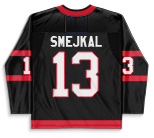Olofsson is expected to skate alongside Peyton Krebs and Zemgus Girgensons on the Sabres' fourth line. He has four goals and eight assists in 30 games this season.

Olofsson is expected to skate alongside Peyton Krebs and Zemgus Girgensons on the Sabres' fourth line. He has four goals and eight assists in 30 games this season.

Deslauriers was a healthy scratch for the Flyers' previous contest but will draw back into the lineup Thursday on the fourth line. The 32-year-old grinding left-winger has yet to score in 2023-24, but has three assists, 34 SOG, 39 PIMs and a -6 plus/minus in 36 games played.

Gardner last appeared in the NHL in 2021-22 with the Dallas Stars and has two points (1G/1A) in 40 career NHL games but will make his Flyers' debut Thursday vs. Columbus. The 27-year-old draws into the lineup as Morgan Frost and Cam Atkinson are surprisingly scratched Thursday.

Frost has only one assist in his last four games and finds himself the odd man out of the Flyers' lineup Thursday as Rhett Gardner makes his Philadelphia debut. The 24-year-old Frost is no stranger to being healthy scratched this season, as he has not dressed for 10 games so far already this season but still has five goals and 11 points in the 27 games he has played.

It has been 22 games since Atkinson found the back of the net and he will take a breather Thursday as a healthy scratch vs. Columbus. The 34-year-old right-winger will be replaced by Rhett Gardner, who is making his Flyers debut. When Atkinson does return he will look to build off the eight goals, 10 assists, 113 SOG, 14 PIMs and a -9 plus/minus he has amassed across 37 games prior to the scratch.

Walker earned his call up from Springfield after producing 29 points (13G/16A) in 30 games played and is expected to make his season debut Thursday vs. Vancouver. The 29-year-old left-winger appeared in 58 games for the Blues in 2022-23, where he had two goals, eight assists, 43 SOG, 25 PIMs and a +10 plus/minus.

John Beecher will draw back into the lineup for the Bruins on Thursday, prompting the team to have Lauko serve as a health scratch. The 23-year-old Lauko has been held without a point in 14 straight games.

Jakub Lauko will be a healthy scratch on Thursday, allowing Beecher to re-enter the lineup for the Bruins. Beecher last played on December 31st, ending a run of 12 straight games in which he recorded only a single point (0G / 1A).

Zack MacEwen (illness) and Jacob Bernard-Docker (healthy scratch) are both expected to be out of the lineup on Thursday, allowing Angus Crookshank and Smejkal to draw back into the lineup. Smejkal has spent most of the season with the Belleville Senators of the AHL, scoring nine points (3G / 6A) in nine games.

Zack MacEwen (illness) and Jacob Bernard-Docker (healthy scratch) are both expected to be out of the lineup on Thursday, allowing Crookshank and Jiri Smejkal to draw back into the lineup. Crookshank has spent most of the season with the Belleville Senators of the AHL, scoring 21 points (10G / 11A) in 24 games.

Bernard-Docker will be a healthy scratch for the Senators after playing 15 consecutive games, scoring five points (3G / 2A) in that stretch. Angus Crookshank and Jiri Smejkal are both expected to draw back into the Senators lineup.

Karlsson is expected to skate on a line with Andrei Kuzmenko and Nils Aman in his first game since December 5th. Through three games this season, Karlsson has yet to record a point while averaging 10:26 time-on-ice.

Linus Karlsson is expected to re-enter the Canucks lineup on Thursday as Hoglander will be a healthy scratch for the first time in nearly two months. Hoglander has zero points in his last four games, firing only three shots on goal in the process.

Fasching will get the short end of the straw on Thursday, being healthy scratched to allow Matt Martin to draw back into the lineup for the Islanders. Fasching has played 15 straight games for the Islanders, finding ways to add sporadic offensive contribution through limited minutes (12:01 ATOI), scoring four points (1G / 3A).

Hudson Fasching will be a healthy scratch on Thursday, allowing Martin to play for only the third time since November 16th. In his last two games, Martin averaged over 10 minutes per night, recorded a five-minute fighting major, fired four shots on goal, and four hits.

Aman will return to the lineup after sitting out the last contest for the Canucks and will join a line with Andrei Kuzmenko and Linus Karlsson. Through 14 games this season, Aman has four points (2G / 2A), nine blocks, and is averaging 10:38 time-on-ice.

Louis Crevier will be a healthy scratch on Thursday, allowing Megna to make his Blackhawks debut after being claimed off of waivers from the Seattle Kraken on Wednesday. Megna has spent most of the season in the press box for the Kraken, being limited to only two games with the Coachella Valley Firebirds, scoring one point (1G / 0A). He has 141 NHL games under his belt, tallying 25 points (4G / 21A) in time split between the Anaheim Ducks, San Jose Sharks, and Seattle.



Olivier will re-enter the Blue Jacket's lineup on Thursday against the Philadelphia Flyers in favour of Brendan Gaunce, who will serve the game as a healthy scratch. Olivier last played on December 27th, registering two shots and two hits in 9:51 time-on-ice.
